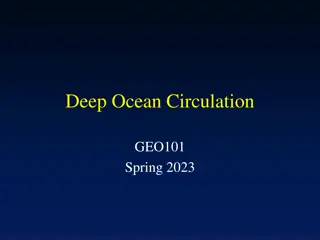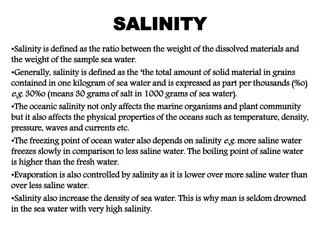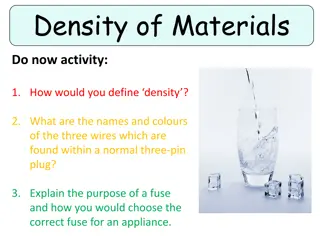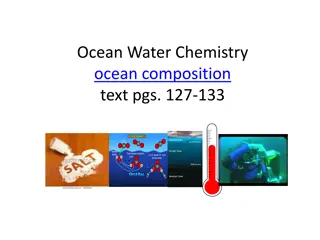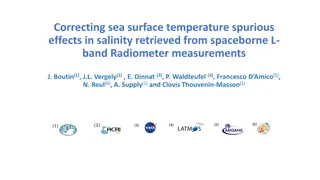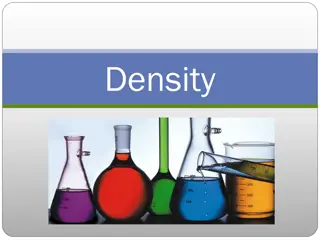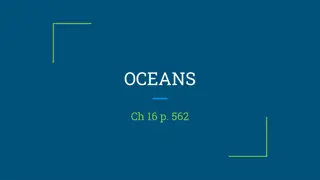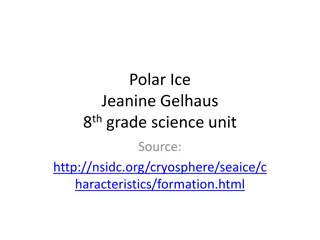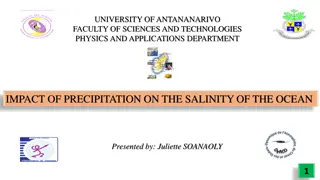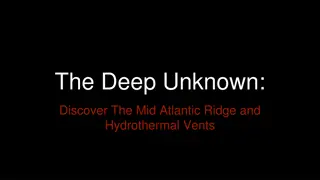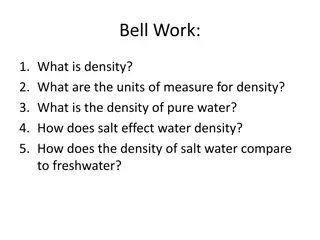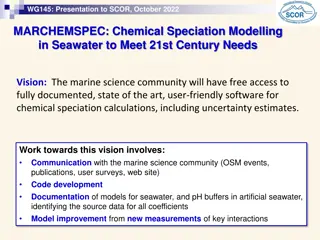Understanding Salinity in Seawater: Density, Composition, and Variations
Seawater is denser than freshwater due to dissolved mineral matter, contributing to its salty flavor. Salinity, measured in ppt, indicates the grams of minerals per kg of seawater. The average salinity is 35 ppt, varying between 33-38 ppt. Distillation is essential to purify water by removing dissolved substances. Brackish water (~33 ppt) and hypersaline water (>38 ppt) offer insights into different water compositions. The Dead Sea, with 280 ppt salinity, demonstrates extreme salt levels.
Download Presentation

Please find below an Image/Link to download the presentation.
The content on the website is provided AS IS for your information and personal use only. It may not be sold, licensed, or shared on other websites without obtaining consent from the author. Download presentation by click this link. If you encounter any issues during the download, it is possible that the publisher has removed the file from their server.
E N D
Presentation Transcript
Density and Salinity Seawater has a greater density than fresh water Dissolved mineral matter gives seawater its saline or salty flavor Salinity is the measure of the number of grams (g) of minerals per kilogram (kg) of seawater, parts per thousand (0/00) or(ppt)
Salinity (ppt) = dissolved minerals (g) 1000 g seawater The average salinity of seawater is about 35 g/kg of seawater (35 ppt) Seawater ranges from 33 ppt 38 ppt
Water is not pure unless it has been distilled several times) to remove dissolved matter When water is boiled, only water molecules escape into the air, leaving heavier minerals behind Video, video2, video3 Freshwater lakes, rivers, and streams all contain some dissolved matter, 1 ppt or less (Fig. 2.11A) distilled (boiled and condensed
Brackish water and sea water, ~33 ppt (Fig. 2.11B) Hypersaline seawater and is sometimes found in tide pools, >38 ppt (Fig. 2.11C) Brackish water is a mixture of fresh Hypersaline (brine) (brine) is very salty
Fig. 2.11. estuary, Oregon (C C) Barber s Point tidepools, O ahu, Hawai i Fig. 2.11. (A A) Wailua Falls, Kaua i, Hawai i (B B) Columbia River
One of the worlds saltiest lakes, the Dead Sea, is 280 ppt or 28% salt! Located between Jordan and Israel
Area gets very little rain and is very hot Water evaporates due to the heat and lack of rain salts are left behind
Only a certain amount of salt can dissolve in water The Dead Sea is so salty that salt precipitates out of the water and piles up at the bottom of the lake White crystallized salt covers everything along the shores
This environment is too salty for most organisms Only specially adapted bacteria and fungi have been found living in the Dead Sea
The Dead Sea is so dense that it is hard to swim because people are so buoyant Most people who swim on their backs in the Dead Sea look like they are reclining on underwater chairs Courtesy of Christina Roeschel and Valerie Blaisdell Presdee SF. Fig. 2.3 news in the Dead Sea. Try doing this in the ocean or a fresh water lake! SF. Fig. 2.3. Catching up on the
Surface is >1,300 feet below sea level. The deepest part is >2,300 feet below sea level Down to ~130 feet 300 g salt/kg seawater Below 300 feet 332 g salt/kg seawater (saturated)
Diving divers have to carry 90 pounds (40 kilograms) of weight to decrease buoyancy Full face masks to protect eyes and mouths swallowing Dead Sea salt water would cause the larynx to inflate, resulting in immediate choking and suffocation the intensely salty water would instantly burn and likely blind the eyes http://news.nationalgeographic.com/news/2011/09/110928-new-life-dead-sea-bacteria-underwater- craters-science/?source=link_fb20110928news-lifeformsdeadsea#
http://www.extremescience.com/dead- sea.htm http://news.nationalgeographic.com/news/2 011/09/110928-new-life-dead-sea- bacteria-underwater-craters- science/?source=link_fb20110928news- lifeformsdeadsea#
In Utah Largest natural lake west of the Mississippi River Salty because it does not have an outlet Remnant of Lake Bonneville; a great ice age lake that rose from a small saline lake 30,000 years ago http://www.utah.com/stateparks/great_salt_lake_facts.htm
Too saline to support fish and most other aquatic species Some algae lives in the lake Brine shrimp and brine flies eat the algae Brine shrimp eggs are harvested commercially and are sold overseas as prawn food Bridger Bay place to float on the lake http://www.utah.com/stateparks/great_salt_lake_facts.htm
Pruney wrinkling of wet digits evolved for a reason Ed Yong http://www.nature.com/news/2011/110628/full/n ews.2011.388.html Pruney fingers grip better: Theory suggests wrinkling of wet digits evolved for a reason Ed Yong fingers grip better: Theory suggests
Both temperature and salinity affect density The more minerals dissolved in each mililiter (mL) of water, the greater the density of the water If density and temperature of a given water sample are know, salinity can be determined from a graph (Fig. 2.13)
When salinity is not known, one of the most common methods for determining the salinity of a solution is to: Measure the density of the solution. Convert the density measurement to salinity. A hydrometer can be used to measure density if the temperature of the sample is known. video
A hydrometer that measures the density of a solution by floating in a liquid The higher the density of the liquid the higher the hydrometer will float the higher the scale will stick out of the water The density line of the hydrometer is read at the surface of the liquid hydrometer is an instrument Fig. 2.12. aquarium hydrometer showing the density range of water samples in g/mL Fig. 2.12. An
Hydrometer calibrated for a range of densities 1.000 distilled water 1.000-1.010 fresh water 1.010- <1.033 brackish water 1.033-1.038 seawater >1.038 hypersaline (brine))
Lower hydrometer into solution carefully (do not drop or it may break because it is glass) Read at the bottom of the meniscus video
Fig. 2.13 Relationships between temperature, density, and salinity Temperature Horizontal (x) Density Vertical (y) Salinity curved Temperature ( C)
http://www.sciencelearn.org.nz/Contexts/Icy -Ecosystems/Sci-Media/Video/Measuring- salinity
Conductivity is a measure of a solutions ability to conduct electricity Electricity needs charged particles in order to flow Generally, the more ions in a solution, the better the solution can conduct electricity
Used by scientists to determine the salinity of sea water Salinity refers to the amount of dissolved salts in a solution Salts are ionic compounds = can be broken down into positive and negative ions
Used in industry to measure ionic content in: Public water supplies Hospitals Breweries
Conductivity is non-ion specific so you can use it to estimate the total amount of dissolved ions (or dissolved solids) NaCl is the primary salt in seawater It dissolves into Na+ and Cl- ions in water The more ions there are, the higher the conductivity
Glue the four activity sheets into your SNB (pages 1-4) on facing pages 1 2 3 4 No prelab for procedures required Finish all parts TODAY!


